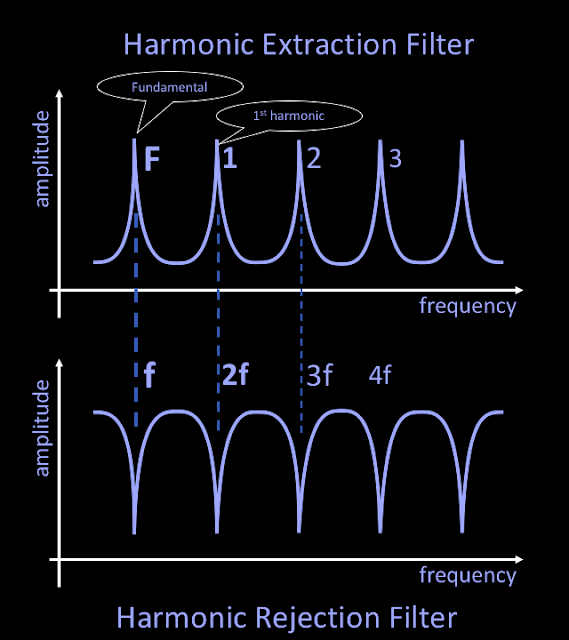The title of the seminar was 'Sound Synthesis Using Residuals', and it described some research that I have been doing.
I promised to make the Nyquist filters for the Audacity audio editor available, and here is the link:
Filters for Audacity
The two filters look like this:
The 'Harmonic Rejector' outputs everything except the harmonics of the input (the 'inharmonics'), if the frequency of the deep notches matches the pitch of the input.
The shapes of these filters are not your ordinary synthesiser staples like low-pass filters. The shape of the harmonic extraction filter is sometimes called a 'teeth' or 'tooth' filter, whilst the harmonic rejection filter is often called a 'comb' filter.
Harmonics and frequencies are related in a not-quite-straightorward way. The pitch frequency is called the Fundamental, and is often represented by the symbol 'f' (for frequency). The first harmonic is at twice the frequency of the fundamental (2f), the second harmonic is at three times the fundamental (3f), and so on until your ears run out of range, or a digital representation of the audio gets close to half of the sampling rate and starts to be filtered out to avoid aliasing. Usually, all you need to know is that you add one to the harmonic to know what multiple of the fundamental frequency it is. So if the fundamental is 100Hz (f), then the 1st harmonic is at 200Hz (2f), the 2nd harmonic is at 300Hz (3f), and so on.
What these filters do is to align the peaks or notches so that they match the harmonics of the input sound, and they then either extract or reject the harmonics in that sound. (This process is not perfect, of course...)
The RUSS synthesis technique uses these two filters to extract the harmonic part, and the inharmonic part, of the input sample. Once you have these two parts (called residuals), then you can use conventional S&S synthesis to create sounds using them as raw material. Separating the sample into two residuals lets you do all sorts of interesting edits...
More information on the RUSS synthesis technique can be found here.









No comments:
Post a Comment